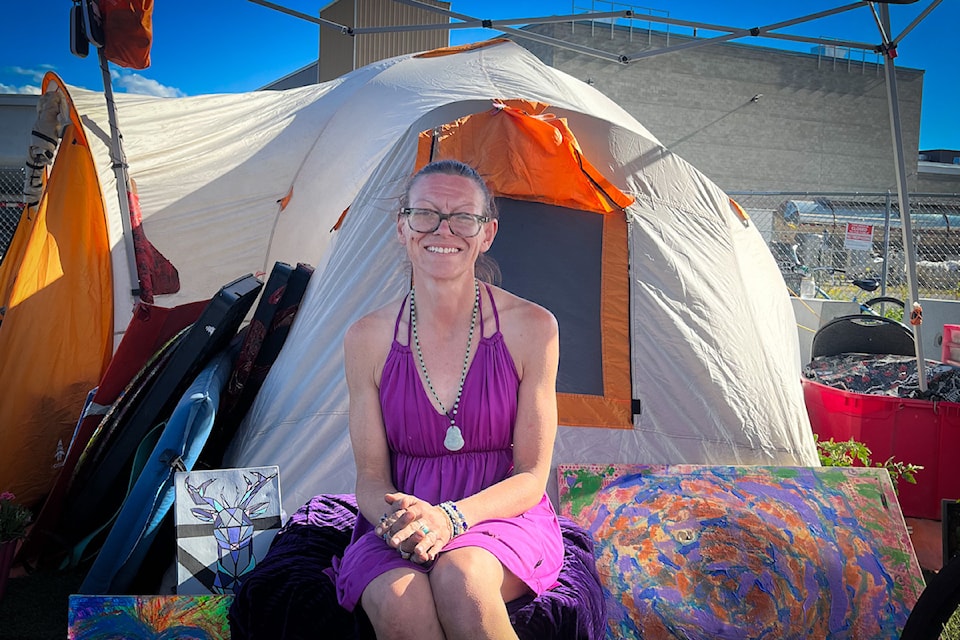When H.O.P.E. Outreach closed its doors two weeks ago, �������� lost a major supplier of boots-on-the-ground harm reduction.
The void left behind by the closure of H.O.P.E. is now being felt on the streets of �������� as people's stock of harm reduction supplies including naloxone kits, condoms, sterile water, clean syringes, pipes, and alcohol swabs begins to dwindle.
Erica Stewart, a former resident of ��������'s Tent City and an advocate for people experiencing un-sheltered homelessness spoke with Capital News about her concern for the future of people who use drugs in the Central Okanagan, now that H.O.P.E. is closed. She witnessed how the delivery of outreach supplies dropped from nearly nightly to only once per week the moment H.O.P.E. dissolved.
Stewart currently lives at the Tiny House Village, also called STEP Place – located across the street from Tent City – but returns to visit her former neighbours as often as possible to help out.
While living at Tent City, Stewart would make sure to collect harm reduction supplies from the H.O.P.E. Outreach workers in order to step in and help her neighbours when they ran out of clean equipment or were overdosing. As a former flight attendant with first-aid training, she was often first on the scene to help out in a crisis.
Now, Stewart's supply of naloxone is diminishing, after using three doses to help her neighbours at Tent City who had overdosed in the last week, and not being able to receive a resupply from outreach workers.
For more than a decade, delivered harm reduction supplies, including the opioid agonist naloxone or Narcan, which is a reversal agent used to treat people who have overdosed, to people on the streets of ��������, in alleys, parks, on downtown streets, and at Tent City, at least five nights each week.
"We were largely the only nighttime agency handing things out," said Angie Lohr, the founder of H.O.P.E. who has now retired and moved back home to Manitoba, where she continues to work in community outreach.
"It was integral in keeping people alive."
Harm reduction services including government-funded needle exchanges became more commonly seen in communities like �������� in the 2010s in an effort to reduce the transmission of infections and diseases like HIV and Hep C. According to Lohr, since most people smoke rather than inject drugs, and use more potent substances, like fentanyl, the landscape of harm reduction has changed.
"We started the Naloxone outreach about ten years ago because no one was helping and people were getting sick and dying," said Lohr.
Lohr said that in the early days of her outreach work, she saw people sharing and reusing needles, using puddle water to mix drugs for injection, and overdosing without access to Narcan. Now, with the closure of H.O.P.E. fears there will be a regression back to those days.
"I fear we are going back there... People are going to start sharing supplies or not using safely," said Lohr.
In ��������, people are able to access harm reduction supplies from outreach centres across the city during business hours from Monday to Friday.
Lorh said that while the harm reduction centres are an excellent and much-needed service, she started the H.O.P.E. street outreach program because many people were not able to make it to the sites while they were open. She explained that many people experiencing homelessness or substance use disorders are not mobile for a variety of reasons, including fear of theft if they leave their tent unattended, mental and physical illness and disabilities, and the shame associated with being seen lining up at an outreach centre.
H.O.P.E. was initially founded with the primary mission of helping vulnerable women who were involved in sex work in the Central Okanagan. However, after seeing the need for harm reduction in ��������, Lohr went to the dollar store, purchased supplies and set out to help people in need.
Lohr said that every agency in �������� is overworked and underfunded and urges individual people and Interior Health to step up to the plate and help out.
"I am sad and devastated for folks on the street."
Interior Health released a statement to Black Press in lieu of an interview regarding the loss of outreach supports on the streets of ��������.
"Interior Health echoes the emotions being felt around the community with these services being available, especially with the toxic drug emergency and the start of the summer when the population in �������� grows... IH shares the concerns related to recent changes to local service agencies. These services provide important social supports for clients that will be difficult to fill."
The health region said that it is working with community partners across the region to ensure people continue to receive the health care, supports and services that they need.
"We are currently collaborating with the agencies and working with a broader Community Action Team (CAT), led by , with other partners and service providers in �������� to discuss how the services can be absorbed by other agencies," said Interior Health.
Interior Health offers harm reduction services at the , , , and . The provides additional information on locating harm reduction services across the province.

